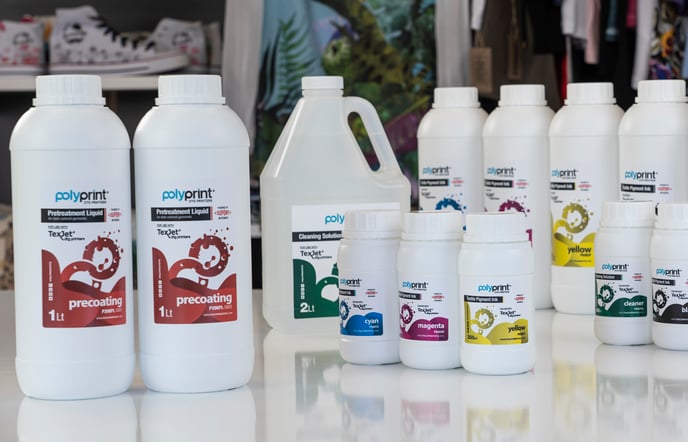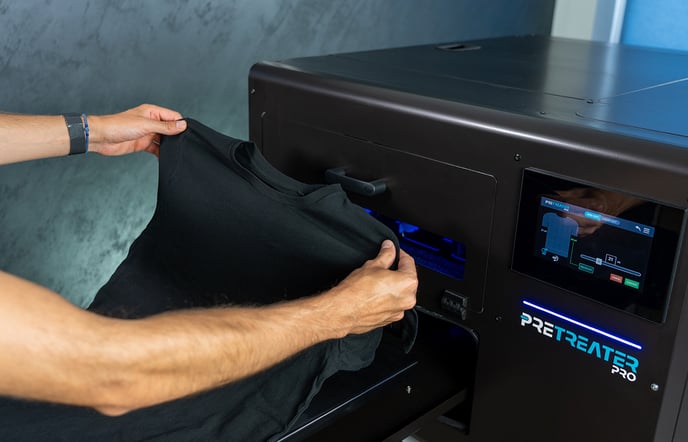The main aspects that you have to consider in order to achieve the best quality possible in direct to garment printing.
Direct to Garment printing is a technology specifically designed to deliver images of outstanding quality that can be achieved if the user take into consideration some simple yet essential factors such as the following:
Fabric type and its quality
Depending on the textile composition, weave, weight and color the end-result will be different, thus the right fabric option will be dictated by the application you are targeting. Generally, 100% cotton is considered ideal for the most DTG applications as this material has excellent ink absorbency that leads to high quality printing, plus its cost efficient. Apart from the natural fibers, synthetic and mixed fiber textiles are common in the clothing industry but they should be treated accordingly to their needs, meaning that maybe they will require some kind of pretreatment before their use in order to give maximum performance.
The color of the garment also matters. All dark textiles either they have natural, synthetic or mixed composition require a coating firsthand, in order to accept the white ink that acts as a base to the CMYK colors, otherwise the inks will sank into the fabric and disappear.
In addition, the printability and by extension the quality can be affected by factors such as silicone finishing, the use of optical brightening agents and the structure of the weaving that make the fabric resistant to absorb the inks.
What types of fabrics are suitable for DTG printing?
Ink & Pretreatment liquid
 The inks and the pretreatment liquids that are being used during the DTG process must be certified and of high quality in order to help the printer perform at his full capability and of course to provide vibrant and accurate colors, sharp details, light resistance and wash fastness that meet industry’s standard performance.
The inks and the pretreatment liquids that are being used during the DTG process must be certified and of high quality in order to help the printer perform at his full capability and of course to provide vibrant and accurate colors, sharp details, light resistance and wash fastness that meet industry’s standard performance.
How to store & maintain inks and pretreatment liquids
DuPont OEKO-TEX® & GOTS-ECOCERT Certifications
Pretreatment application & Curing process

The precoating process of a garment must be such that ensures a smooth, wrinkle-free, homogeneously coated surface that will later allow the inks to be printed on and result in an excellent quality print. Thus, the correct application of the pretreatment liquid prior to printing, whether it is mechanically or manually applied, is of great importance. Also, attention must be given on the fixation parameters of the pretreatment liquids and inks, such as temperature and time, because otherwise the quality and the wash endurance of the print may be downgraded.
PreTreater Pro: Basic pretreating process
Precoating and Polycoating liquids textile applications
Print engine
The core of the DTG process is the printer itself. Keep in mind that for each application the printer must be equipped accordingly in order to give the best printing quality possible for the targeted use. Hence, the printhead specifications have a major impact on the print quality since they are responsible for the desirable sharpness and preciseness of the print.
Main differences & similarities of TexJet DTG printers
Distance from the printhead
The way that digital printing works is about the printhead spraying the ink from a safe distance on to the garment’s surface. So, in order to have a printed image of excellent quality with vibrant colors and sharp details, the correct distance between the printhead’s nozzles and the fabric’s surface must be achieved. This setting can be adjusted either manually or by an automatic system, depending on what the printer has to offer.
Auto height adjustment feature on TexJet echo2 & why it is important
Auto height adjustment feature on TexJet shortee2 & why it is important
Digital file quality
Digital textile printing is the process of transferring a digital image to a printer through a computer and finally on the textile itself. In order to achieve excellent printing quality, the files that are uploaded in the Rip software must be of high resolution, as they are the information that is being transferred to the garment.
Rip compatibility & capabilities
The hardware (printer) and software (Rip) must be compatible with each other otherwise no printing will take place. The right choice of software will provide the user with a variety of options and possibilities, through accessible tools and settings that will make the printing procedure easier and lead up to supreme print quality.
Basic printing process with Digital Factory Apparel Polyprint Edition v10
How to get the best print quality using the features of Digital Factory Apparel Polyprint edition
Printing environment
Environmental parameters such as temperature and humidity are of great importance when it comes to printing quality. The printers in order to give maximum performance must be operated in room temperature (10-30 Celsius) and humidity levels close to 55%. If those conditions are not met, the consistency of the inks will change and possible problems may arise that will affect the printhead’s condition and by extend the printing quality.
Importance of humidity & temperature conditions at my DTG working space
-1.png?height=120&name=Polyprint%20Logo%20(Dark)-1.png)

